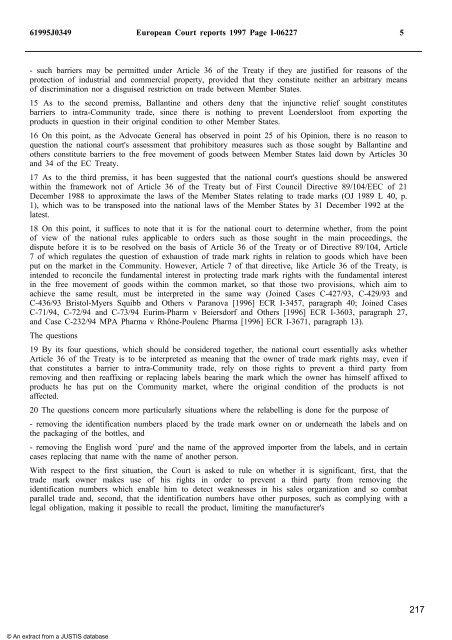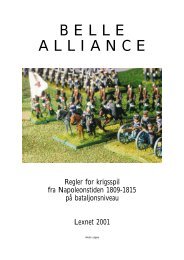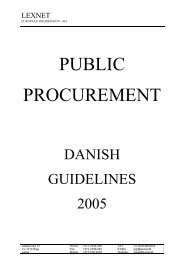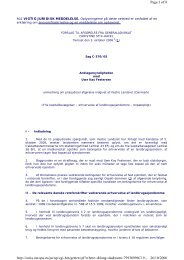Master's Program 2004/2005 Technical and Fiscal Barriers ... - Lexnet
Master's Program 2004/2005 Technical and Fiscal Barriers ... - Lexnet
Master's Program 2004/2005 Technical and Fiscal Barriers ... - Lexnet
You also want an ePaper? Increase the reach of your titles
YUMPU automatically turns print PDFs into web optimized ePapers that Google loves.
61995J0349 European Court reports 1997 Page I-06227 5<br />
- such barriers may be permitted under Article 36 of the Treaty if they are justified for reasons of the<br />
protection of industrial <strong>and</strong> commercial property, provided that they constitute neither an arbitrary means<br />
of discrimination nor a disguised restriction on trade between Member States.<br />
15 As to the second premiss, Ballantine <strong>and</strong> others deny that the injunctive relief sought constitutes<br />
barriers to intra-Community trade, since there is nothing to prevent Loendersloot from exporting the<br />
products in question in their original condition to other Member States.<br />
16 On this point, as the Advocate General has observed in point 25 of his Opinion, there is no reason to<br />
question the national court's assessment that prohibitory measures such as those sought by Ballantine <strong>and</strong><br />
others constitute barriers to the free movement of goods between Member States laid down by Articles 30<br />
<strong>and</strong> 34 of the EC Treaty.<br />
17 As to the third premiss, it has been suggested that the national court's questions should be answered<br />
within the framework not of Article 36 of the Treaty but of First Council Directive 89/104/EEC of 21<br />
December 1988 to approximate the laws of the Member States relating to trade marks (OJ 1989 L 40, p.<br />
1), which was to be transposed into the national laws of the Member States by 31 December 1992 at the<br />
latest.<br />
18 On this point, it suffices to note that it is for the national court to determine whether, from the point<br />
of view of the national rules applicable to orders such as those sought in the main proceedings, the<br />
dispute before it is to be resolved on the basis of Article 36 of the Treaty or of Directive 89/104, Article<br />
7 of which regulates the question of exhaustion of trade mark rights in relation to goods which have been<br />
put on the market in the Community. However, Article 7 of that directive, like Article 36 of the Treaty, is<br />
intended to reconcile the fundamental interest in protecting trade mark rights with the fundamental interest<br />
in the free movement of goods within the common market, so that those two provisions, which aim to<br />
achieve the same result, must be interpreted in the same way (Joined Cases C-427/93, C-429/93 <strong>and</strong><br />
C-436/93 Bristol-Myers Squibb <strong>and</strong> Others v Paranova [1996] ECR I-3457, paragraph 40; Joined Cases<br />
C-71/94, C-72/94 <strong>and</strong> C-73/94 Eurim-Pharm v Beiersdorf <strong>and</strong> Others [1996] ECR I-3603, paragraph 27,<br />
<strong>and</strong> Case C-232/94 MPA Pharma v Rhône-Poulenc Pharma [1996] ECR I-3671, paragraph 13).<br />
The questions<br />
19 By its four questions, which should be considered together, the national court essentially asks whether<br />
Article 36 of the Treaty is to be interpreted as meaning that the owner of trade mark rights may, even if<br />
that constitutes a barrier to intra-Community trade, rely on those rights to prevent a third party from<br />
removing <strong>and</strong> then reaffixing or replacing labels bearing the mark which the owner has himself affixed to<br />
products he has put on the Community market, where the original condition of the products is not<br />
affected.<br />
20 The questions concern more particularly situations where the relabelling is done for the purpose of<br />
- removing the identification numbers placed by the trade mark owner on or underneath the labels <strong>and</strong> on<br />
the packaging of the bottles, <strong>and</strong><br />
- removing the English word `pure' <strong>and</strong> the name of the approved importer from the labels, <strong>and</strong> in certain<br />
cases replacing that name with the name of another person.<br />
With respect to the first situation, the Court is asked to rule on whether it is significant, first, that the<br />
trade mark owner makes use of his rights in order to prevent a third party from removing the<br />
identification numbers which enable him to detect weaknesses in his sales organization <strong>and</strong> so combat<br />
parallel trade <strong>and</strong>, second, that the identification numbers have other purposes, such as complying with a<br />
legal obligation, making it possible to recall the product, limiting the manufacturer's<br />
© An extract from a JUSTIS database<br />
217







